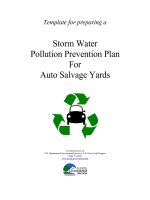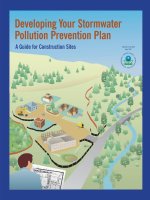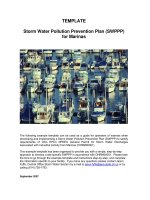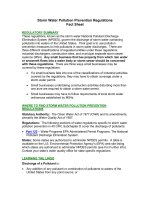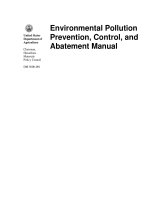Environmental management E363 lecture 6 pollution prevention
Bạn đang xem bản rút gọn của tài liệu. Xem và tải ngay bản đầy đủ của tài liệu tại đây (83.96 KB, 23 trang )
E363 –
ENVIRONMENTAL MANAGEMENT
LECTURE 6 –
POLLUTION PREVENTION
Dr. Nguyen Thi Hoang Lien
POLLUTION PREVENTION AND
COMPLIANCE ASSISTANCE
• Pollution knows no boundaries.
• Pollution prevention can be applied across
various environmental media (i.e., air, water, and
land) to address both point source and nonpoint
sources of pollution.
• Pollution prevention, also known as source
reduction, is any practice that eliminates or
reduces pollution at its source.
• Pollution prevention is achieved through
material substitutions, process changes, and
the more efficient use of natural resources
(e.g., raw materials, energy, water, and other
resources).
• Through pollution prevention, the use and
production of hazardous substances can be
minimized, thereby protecting human health,
strengthening economic well-being, and
preserving the environment.
THE 3 PHASES OF ENVIRONMENTAL ASSESSMENT
BASED ON POSSIBLE INACTIVE HAZADOUS WASTE
CONTAMINATION OF PROPERTY
• Assessment for possible contamination
• Monitoring for extent of contamination
• Remediation of contamination
POLLUTION PREVENTION ACT
1. Proactive “source reduction”
2. Not limited to one medium
POLLUTION PREVENTION
• When feasible, pollution should be prevented
or reduced at the source;
• When prevention is not feasible, pollution
should be recycled in an environmentally safe
manner;
• When prevention or recycling is not feasible,
pollution should be treated in environmentally
safe ways;
• Only when prevention, recycling, or treatment
are not feasible should disposal or releases be
used.
POINT SOURCE POLLUTION
The term "point source" means any
discernible, confined and discrete conveyance,
including but not limited to any pipe, ditch,
channel, tunnel, conduit, well, discrete fissure,
container, rolling stock, concentrated animal
feeding operation, or vessel or other floating
craft, from which pollutants are or may be
discharged. This term does not include
agricultural storm water discharges and return
flows from irrigated agriculture. (USEPA)
• Point source pollution is related to emissions that can be
easily identified with a single discharge source:
- Smokestacks, vents, sewers, small fires, and exhausts from
equipment;
Fossil-fuel
(coal,
oil,
natural
gas)
or
biomass (wood, waste, including yard waste and
metropolitan solid waste and pelletized sewage or animal
waste sludge, waste-generated methane) fired electric
generating plants;
- Portland cement and lime kilns and plants;
- Heavy industrial and petrochemical plants such
as refineries, steel mills, smelters, ore reduction
plants, plastics plants and chemical plants.
NON-POINT SOURCE POLLUTION
• NPS pollution generally results from land
runoff, precipitation, atmospheric deposition,
drainage, seepage or hydrologic modification.
The term "nonpoint source" is defined to
mean any source of water pollution that does
not meet the legal definition of "point source"
in section 502(14) of the Clean Water Act.
• NPS pollution is also called “people pollution”
because much of it is the result of activities
that people do everyday.
• NPS pollution can include:
- Excess fertilizers, herbicides and insecticides from
agricultural lands and residential areas;
- Oil, grease and toxic chemicals from urban runoff
and energy production;
- Sediment from improperly managed construction
sites, crop and forest lands, and eroding
streambanks;
- Salt from irrigation practices and acid drainage
from abandoned mines;
- Bacteria and nutrients from livestock, pet wastes
and faulty septic systems;
-
THE LOGIC OF POLLUTION PREVENTION
• Pollution is a manifestation of inefficient
process and thus, except for Ag-chems (as
intentionally applied) is largely made up of
“by-products”
• If sources of “by-products” can be more
efficient they will reduce waste, save money
and reduce regulatory reaction
• How can environmental manages stimulate
pollution prevention? (education, regulation
or both?)
WHAT YOU CAN DO TO PREVENT NPS POLLUTION
Mining
Become involved in local mining issues by voicing your
concerns about acid mine drainage and reclamation
projects in your area.
Forestry
• Use proper logging and erosion control practices on
your forest lands by ensuring proper construction,
maintenance, and closure of logging roads and skid
trails.
• Report questionable logging practices to state and
federal forestry and state water quality agencies.
Agriculture
• Manage animal waste to minimize contamination of
surface water and ground water.
• Protect water by using less pesticides and fertilizers.
• Reduce soil erosion by using conservation practices and
other applicable best management practices.
• Use planned grazing systems on pasture and rangeland.
• Dispose of pesticides, containers, and tank rinsate in an
approved manner.
Urban Stormwater Runof
• Keep litter, pet wastes, leaves and debris out of street gutters
and storm drains—these outlets drain directly to lake, streams,
rivers and wetlands.
• Apply lawn and garden chemicals sparingly and according to
directions.
• Dispose of used oil, antifreeze, paints and other household
chemicals properly—not in storm sewers or drains. If your
community does not already have a program for collecting
household hazardous wastes, ask your local government to
establish one.
• Clean up spilled brake fluid, oil, grease and antifreeze. Do not
hose them into the street where they can eventually reach local
streams
and
lakes.
• Control soil erosion on your property by planting
ground cover and stabilizing erosion-prone areas.
• Encourage local government officials to develop
construction erosion and sediment control
ordinances in your community.
• Have your septic system inspected and pumped, at
a minimum every three to five years, so that it
operates properly.
• Purchase household detergents and cleaners that
are low in phosphorous to reduce the amount of
nutrients discharged into our lakes, streams and
coastal waters.
GREEN PURCHASING PRACTICES
AND POLLUTION PREVENTION
• Green purchasing practices (e.g. purchasing
energy efficient equipment, low toxicity
cleaning materials, recycled content products)
are important components of effective
pollution prevention programs and can also
lead to cost savings, manifested in reduced
energy costs and reduced hazardous material
disposal costs.
TOP POLLUTION PREVENTION
OPPORTUNITIES
• Adopt a purchasing policy that promotes the
integration of environmental and health
criteria in all product specifications;
• Educate tribal staff about health effects
associated
with
chemicals
commonly
contained in the products they use or are
exposed to, and provide information on
alternatives;
• Choose one department/operation at a time to
incorporate
environmentally-preferable
products; start with a group where you are most
likely to succeed. Review final product
specifications with product users or operation
supervisors to ensure that their needs are
satisfied;
• Encourage users to choose environmentallypreferable products;
• Involve product end-users throughout the
decision-making process. Request that vendors
perform product demonstrations for staff, and
compare
products;
• Review all purchases and read all product Material
Safety Data Sheets and product labels for potential
environmental and health impacts prior to purchase
and use;
• Check products for durability;
• Make sure products can be safely used and stored
(e.g., adequate storage locations and ensure personal
protective equipment is available);
• Avoid purchasing products that are potentially
harmful to the user, public, or environment (e.g.,
contain known or suspected carcinogens or other
toxic ingredients), or purchase the least toxic products
available to do the job;
• Prevent the generation of hazardous wastes in
operations by eliminating products that contain
hazardous ingredients;
• Participate in cooperative purchasing ventures
with other jurisdictions to increase availability of
environmentally-preferable products, leverage
purchasing power, and reduce internal costs
associated with the formal bid process;
• When researching environmental purchasing,
utilize resources and expertise available from
vendors, manufacturers, government agencies,
non-profits, and other organizations;
• Consider environmental and health impacts
associated with a product's life cycle prior to
drafting bid specifications ("product life cycle"
includes
raw
material
extraction
or
development,
product
manufacturing,
transportation to market, product use, and
disposal);
• Begin an energy conservation program and
invest in energy-efficient equipment and
building
design
(e.g., EPA
“ENERGY
STAR” certified
equipment
and
require
equipment installers to activate efficiency
features upon product installation);
• Implement waste reduction activities (e.g.,
lease agreements that require vendors to take
responsibility for products as they become
obsolete; require prospective bidders to avoid
excess paper and packaging in their bid and
proposal submittals such as avoiding plastic
covers and dividers, using both sides of paper,
and using post-consumer recycled content
paper; specify copiers and printers with
double-sided printing capabilities).




